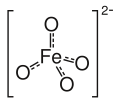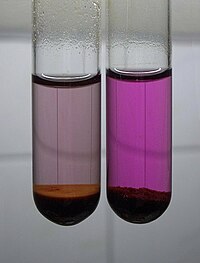高鐵酸鹽
高铁酸盐的高铁酸根是无机阴离子,化学式[FeO₄]²⁻。它对光敏感,其化合物和溶液呈淡紫色,为已知对水稳定的極强氧化剂。尽管归为弱碱,高铁酸盐浓溶液仍有腐蚀性,且会烧伤皮肤,只能在強鹼环境稳定存在。
| 高铁酸盐 | |
|---|---|

| |

| |
| IUPAC名 Ferrate(VI) | |
| 系统名 Tetraoxoironbis(olate)[來源請求] | |
| 别名 | 铁酸盐 |
| 识别 | |
| CAS号 | 16836-06-9 |
| PubChem | 25000034 |
| ChemSpider | 21865127 |
| SMILES |
|
| InChI |
|
| InChIKey | XGBDPAYTQGQHEW-WTZHFVRHAI |
| ChEBI | 30992 |
| 性质 | |
| 化学式 | FeO42- |
| 摩尔质量 | 119.843 g mol-1 g·mol⁻¹ |
| 若非注明,所有数据均出自标准状态(25 ℃,100 kPa)下。 | |
命名法
编辑ferrate通常指代高铁酸根,但也可以指其它含铁阴离子,當中许多比[FeO₄]²⁻盐常见。这包括有强还原性的四羰基铁酸二钠Na₂[Fe(CO)₄]和三价铁络合物四氯铁酸根[FeCl₄]⁻。铁的含氧阴离子铁(V)酸根[FeO₄]³⁻和铁(IV)酸根[FeO₄]⁴⁻也同样存在,但其研究较少。这些也称为高铁酸根。[1]
合成
编辑高铁酸盐可在碱性条件用强氧化剂在水溶液中氧化铁,或加热固态的铁屑和粉状硝酸钾的混合物而形成。[2]
- 2Fe(OH)₃+3OCl⁻+4OH⁻ → 2[FeO₄]²⁻+5H₂O+3Cl⁻
性质
编辑高铁酸根离子不稳定,在中性[2]或酸性环境会分解为三价铁:[3]
- [FeO₄]²⁻+3e⁻+8H⁺ ⇌ Fe³⁺+4H₂O
还原过程中间体中铁的氧化态有+5和+4[4]。这些阴离子甚至比高铁酸根活泼[5]。高铁酸根在碱性条件更稳定,酸值为8或9时能存在8至9小时[5]。
稀高铁酸盐水溶液为粉红色,浓时为深红或紫色[4][6]。与高锰酸盐相比,高铁酸盐是更强的氧化剂[7],可将三价铬氧化成重铬酸盐[8],或将氨氧化成氮分子[9]。
参见
编辑参考資料
编辑- ^ Graham Hill; John Holman. Chemistry in context 5th. Nelson Thornes. 2000: 202. ISBN 0-17-448276-0.
- ^ 2.0 2.1 R. K. Sharma. Text Book Of Coordination Chemistry. Discovery Publishing House. 2007: 124–125. ISBN 81-8356-223-X.
- ^ 3.0 3.1 3.2 Gary Wulfsberg. Principles of descriptive inorganic chemistry. University Science Books. 1991: 142–143. ISBN 0-935702-66-0.
- ^ 4.0 4.1 4.2 Egon Wiberg; Nils Wiberg; Arnold Frederick Holleman. Inorganic chemistry. Academic Press. 2001: 1457–1458. ISBN 0-12-352651-5.
- ^ 5.0 5.1 Gary M. Brittenham. Raymond J. Bergeron , 编. The Development of Iron Chelators for Clinical Use. CRC Press. 1994: 37–38. ISBN 0-8493-8679-9.
- ^ John Daintith (编). Oxford dictionary of chemistry 5th. Oxford University Press. 2004: 235. ISBN 0-19-860918-3.
- ^ Kenneth Malcolm Mackay; Rosemary Ann Mackay; W. Henderson. Introduction to modern inorganic chemistry 6th. CRC Press. 2002: 334–335. ISBN 0-7487-6420-8.
- ^ Amit Arora. Text Book Of Inorganic Chemistry. Discovery Publishing House. 2005: 691–692. ISBN 81-8356-013-X.
- ^ Karlis Svanks. Oxidation of Ammonia in Water by Ferrates(VI) and (IV) (PDF). Water Resources Center, Ohio State University: 3. June 1976 [2010-05-04].
- ^ Stanley E. Manahan. Environmental chemistry 8th. CRC Press. 2005: 234. ISBN 1-56670-633-5.